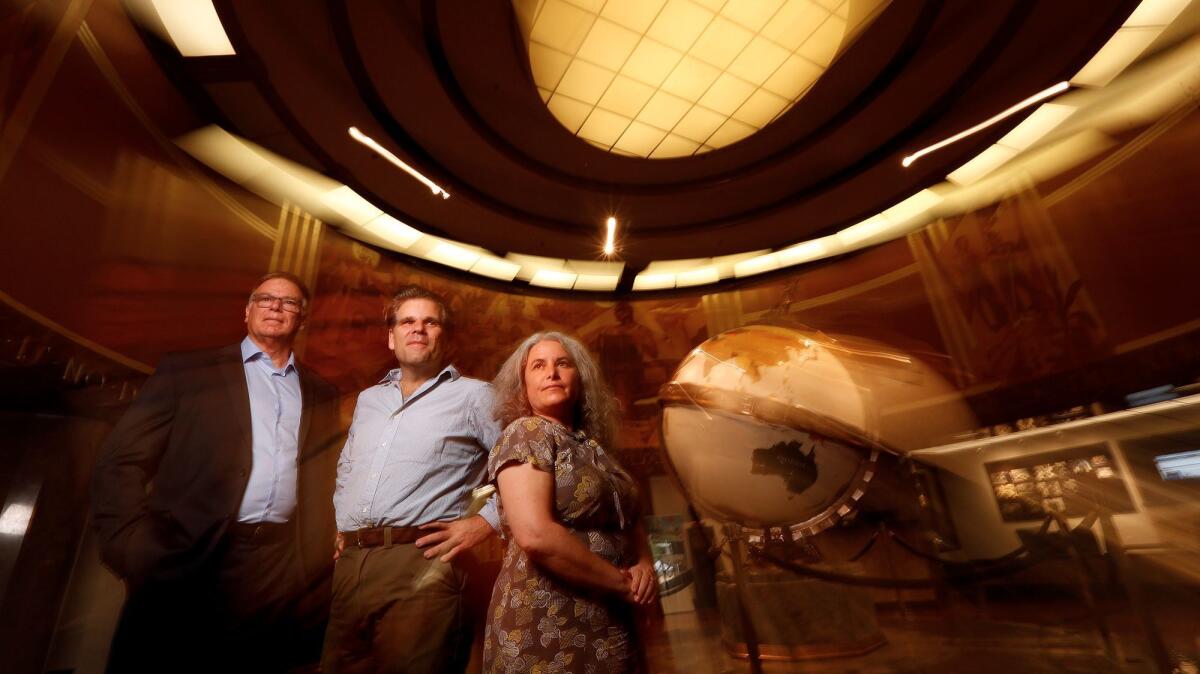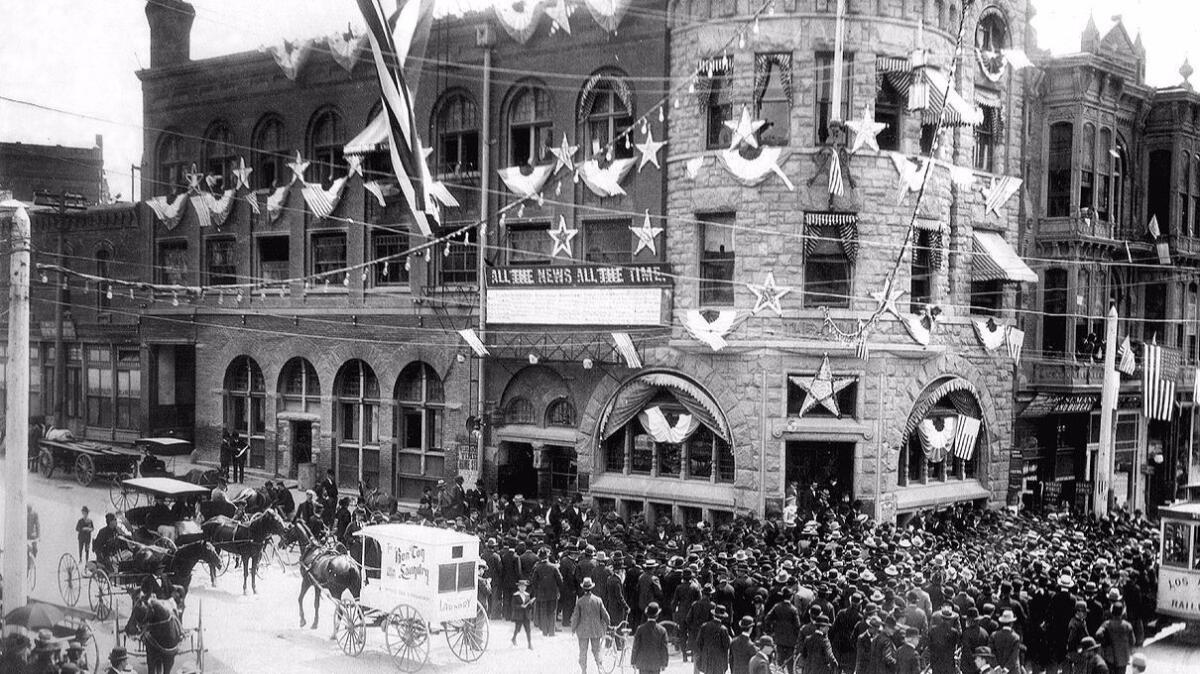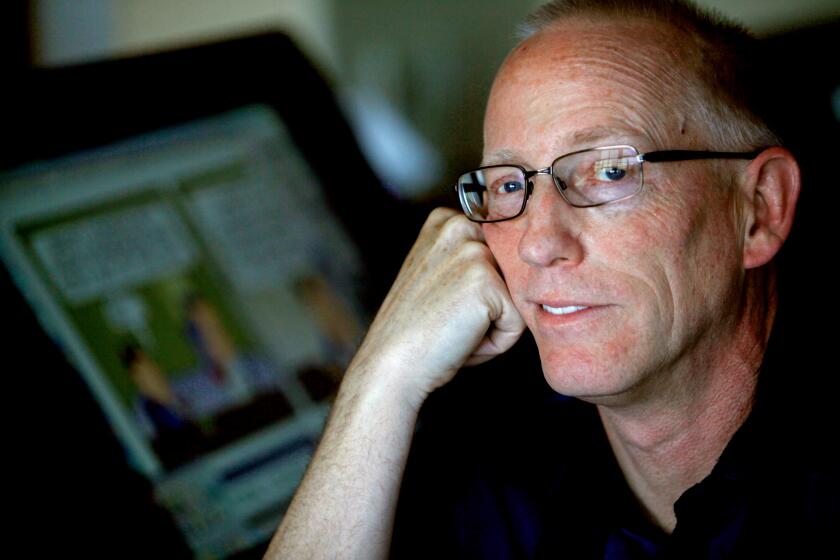The 1910 bombing of the Los Angeles Times has been the subject of books and film. Now it’s a bus tour

- Share via
The weapon: 16 sticks of dynamite and a windup alarm clock.
The target: The old Los Angeles Times building, an 1886 brick-and-granite edifice known as “the fortress,” on Broadway and First Street, across the street from where The Times is located today.
The bomber: J.B. McNamara, who was linked to an ironworkers union that ordered the attack — part of a radical bombing campaign to go after anti-union strongholds in the early days of the 20th century.
Twenty-one people died in the early hours of Oct. 1, 1910, when the explosive device ripped an entire wing off The Times building. A night editor and a telegraph operator were among the dead, and dozens of others were wounded and maimed. A report published in The Times two days after the incident described the scene as an “awful pit of death.”
Heralded as the “crime of the century,” the bombing has been the subject of books (such as “Deadly Times” by Lew Irwin) and it has figured in documentaries (Peter Jones’ “Inventing L.A.: The Chandlers and Their Times”).
Now it is the subject of a tour.
Esotouric, the decade-old outfit founded by Kim Cooper and Richard Schave, known for exploring the curious recesses of Los Angeles in the form of thoroughly researched historical tours, debuts a new excursion on Saturday with stops at key sites associated with the bombing: the Baltimore Hotel, on 5th and Los Angeles streets, where the bomber McNamara stayed while he cased The Times; the site of the MacArthur Park home where Gen. Harrison Gray Otis, the proprietor of The Times, lived (and where another bomb was found); Hollywood Forever Cemetery, where the monument to The Times dead resides; and the current Times building, which features the bombing in a historical timeline in the Art Deco Globe Lobby. The building’s cornerstone, laid in 1934, contains a copper box with a list of the dead. (KCET has a good story on this.)
Leading the trip will be retired L.A. County Sheriff’s Det. Michael Digby, who has worked on the Sheriff’s Department bomb squad, and who teaches the 1910 bombing in seminars on forensics.
“We’ll drive the route and we’ll follow the clues and follow the evidence,” says Digby, who is also the author of “The Bombs, Bombers and Bombings of Los Angeles.” “This was the biggest bomb event to occur in Los Angeles.”

A self-described history nerd and bomb nerd, Digby says, “This case really has everything. It has the use of informants — both poorly and properly [used]. It has the chase. Every single soul that needed to be interviewed got interviewed … And the use of forensics were spot-on: fingerprints, witness identification, comparing dust samples and comparing dynamite samples.”
It was a seminal moment for Los Angeles in other ways too.
“The birth of modern Los Angeles is intrinsically connected to the bombing,” says Schave, who loves that this slice of Los Angeles history comes with a colorful cast of characters.
There is the chief protagonist, the bountifully mustachioed Gen. Otis, a veteran of the Civil War and the Spanish American War, and staunch anti-union man.
“Gen. Otis is a great, huge character in Los Angeles history,” says Schave. “[He] is this deranged, megalomaniacal general — think Dr. Strangelove — who drives around with a machine gun mounted to the hood of his car.
“And he has this obsession with Los Angeles as the ‘Great White Spot’ … and it’s everything you think it means. It’s no unions and the robber barons can come in with their industries and just go! And the poor people live far away.”
Adds Digby: “Nobody was more anti-union than Gen. Otis.”
The birth of modern Los Angeles is intrinsically connected to the bombing.
— Richard Schave, Esotouric
Harry Chandler, Otis’ powerful son-in law, missed being killed in the blast by a matter of minutes. (His wife, Marian Otis, had called and asked that he come home.)
“Without Harry Chandler, we wouldn’t have Los Angeles as we know it,” says Cooper.
Chandler and his father-in-law were part of the syndicate that pushed the city of Los Angeles to build a 238-mile aqueduct from the Owens Valley to Los Angeles after buying up land in the San Fernando Valley. (The basis for the 1974 movie “Chinatown,” starring Jack Nicholson and Faye Dunaway.)
“Chandler’s vision was that what is good for the Chandler family is good for Los Angeles,” adds Schave. “In that day, that’s what people did — that’s how leaders thought. Ego filled the political and public policy agenda.”
William J. Burns, the dogged detective who did much of the legwork on the case, later became director of the Bureau of Investigations, a precursor to the FBI.
Defending the bomber J.B. McNamara and his brother, J.J., who ordered many of the union bombings, were two famous lawyers: Clarence Darrow, whose career was nearly destroyed after he was accused of jury tampering in the case but went on to become the star of the Scopes Trial (the Tennessee trial over the teaching of evolution) and Job Harriman, who was on his way to becoming Los Angeles’ first socialist mayor until the McNamaras declared their guilt in open court via a plea deal Darrow arranged.
After Harriman lost the mayoral race election, he went off to the desert to establish a utopian community called Llano del Rio, thereby marking an end to a marked leftist presence in Los Angeles. (Esotouric has a tour about that, too.) Chandler further cemented his position as a Los Angeles power player and helped see to the completion of the Los Angeles Aqueduct. And The Times was resuscitated in a new Art Deco building across First Street in the 1930s — where it remains to this day.
The tour represents another culmination of sorts: Esotouric this year is celebrating its 10th anniversary of leading singular treks around Los Angeles.
“And 10 years into it,” says Cooper, “we’re more obsessed with Los Angeles than we have ever been.”
The 1910 Bombing of the Los Angeles Times
When: Noon-4 p.m. Saturday
Where: Meet at the Daily Dose cafe in the Arts District, 1820 Industrial St., downtown Los Angeles
Price: $75 per person; advance reservation required
Info: esotouric.com
Sign up for our weekly Essential Arts & Culture newsletter »
ALSO
Bombing of The Times in 1910 set labor back a generation
Q&A How artist Camilo Ontiveros acquired the belongings of a DACA deportee and what he did with them
More to Read
The biggest entertainment stories
Get our big stories about Hollywood, film, television, music, arts, culture and more right in your inbox as soon as they publish.
You may occasionally receive promotional content from the Los Angeles Times.











